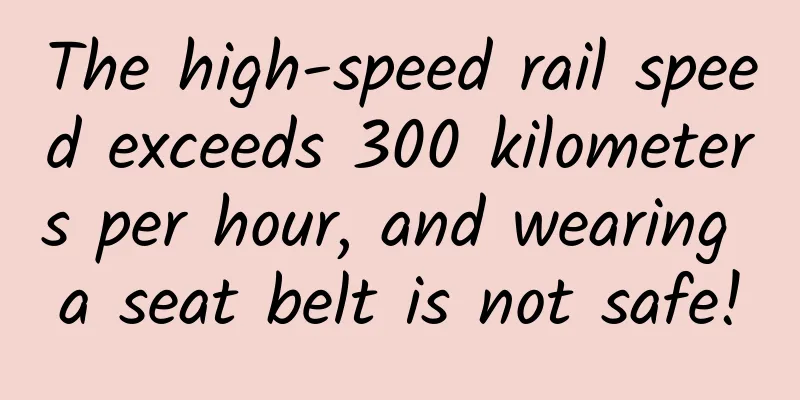The high-speed rail speed exceeds 300 kilometers per hour, and wearing a seat belt is not safe!

|
Review expert: Wang Shengwei, Senior Engineer, Beijing Municipal Engineering Design and Research Institute Co., Ltd. The summer travel season is about to begin. Whether it is the longing for a trip thousands of miles away or the eagerness to return home, travel safety is always something we cannot ignore during our journey. Image source: China Railway On airplanes, we are fastened by seat belts to prevent turbulence; in cars, seat belts are our "lifeline", protecting us from the impact of sudden braking or collisions. However, when we step on the fast-moving high-speed train, no one reminds us to fasten our seat belts. Why is that? PART 01 Why should we always wear seat belts on airplanes and cars? During our journey, whether we are on an airplane thousands of miles high or in a car speeding on the ground, we may encounter sudden air turbulence or drastic changes in speed. These sudden events are often accompanied by huge changes in acceleration, causing varying degrees of impact on our bodies. When an aircraft enters an unstable airflow area, it may encounter sudden updrafts or downdrafts. Such violent turbulence will make passengers and crew members feel obvious weightlessness or overweight, which can easily cause physical discomfort or even injury. Similarly, if a car speeding on the ground encounters emergency braking or a collision, the speed will suddenly change. Due to inertia, the passengers in the car will continue to move forward at the original speed. This sudden speed change and inertia force may cause injury to the passengers. The design of the seat belt takes these potential dangers into consideration. It has a special mechanism inside - an emergency self-locking device . When the vehicle or aircraft accelerates or decelerates sharply, the seat belt will quickly lock, restricting the movement of the passenger's body and thus reducing the damage caused by inertia . PART 02 How to ensure passenger safety without seat belts High-speed rail does not rely on seat belts to ensure the safety of passengers, but achieves this through excellent stability, safe anti-collision seats, intelligent early warning systems, strict safety management, etc. The comprehensive application of these high-tech technical means and management measures has reduced the occurrence of emergencies and greatly improved the safety of high-speed rail. Let’s take a look at the “seat belts” on high-speed trains. First of all, the high-speed rail is very stable , and people can hardly feel that it is running at high speed. This is due to the advanced suspension system of the high-speed rail and the design of "ballastless track". It refers to small pieces of stone. Conventional railways are built on a foundation composed of small pieces of stone, and then sleepers or concrete sleepers are laid, and finally rails are laid. This kind of track is called ballasted track, which is not suitable for high-speed trains. Ballasted track vs ballastless track Source: Science of mechanics Ballastless track is a track structure that uses concrete, asphalt mixture and other integral foundations to replace gravel. It can avoid ballast splashing to the greatest extent, and has good smoothness and high stability. At the same time, the high-speed rail track has high linear design indicators, is relatively straight, and has a large curve radius, which can ensure that the train can basically move forward in a straight line without large lateral or longitudinal vibrations. Moreover, the acceleration and deceleration process of the high-speed rail is extremely smooth , and passengers will hardly feel any obvious push on the back or leaning forward, so the seat belts seem a bit "redundant" here. If you stand a coin on the car window, it will not fall down even when the car is driving at high speed. Image source: Hubei Emergency Management Secondly, improving the design of high-speed rail seats can enhance passenger safety in the event of an accident. At present, the seats commonly used in high-speed railways around the world are anti-collision safety seats, which can collapse and deform in time when the rear passengers' heads or knees hit the seat backs forward, preventing passengers from being trapped and ensuring that passengers can escape as soon as possible after an accident. Based on this feature, the seat fabrics are generally made of leather and textile materials. In addition, the fabrics of high-speed rail seats also have good flame retardancy to prevent fires in closed carriages with dense traffic. Safety seats on Fuxing trains Source: Li Kepu Thirdly, the high-speed rail’s intelligent early warning system can also prevent dangerous incidents in a timely manner, greatly reducing the accident rate and improving safety performance. The high-speed rail’s intelligent early warning system is like “clairvoyant eyes” and “superb ears”. They can capture abnormalities in a timely manner, whether it is bad weather, track abnormalities, or other potential safety hazards, nothing can escape their “eagle eyes”. The high-speed rail's intelligent early warning system also has an "intelligent brain" that can quickly analyze situations and make decisions. The system uses advanced sensors and algorithms to monitor the train's operating status and track environment in real time to ensure that the train runs safely and stably. If potential danger is detected, the system will automatically adjust the train's speed or take other necessary measures to ensure the safety of passengers. For example, there are 16 seismometers installed between Shifang West and Zhenjiangguan on the Sichuan-Qinghai Railway, forming a high-speed railway earthquake early warning system. When the EMU train control system and on-board seismic device send a level III alarm message, the train control system and on-board seismic device will control the train to brake urgently and cut off the power supply of the contact network to ensure the safety of the EMU train. Staff members inspect the earthquake early warning system of the Sichuan-Qinghai Railway High-Speed Railway. Source: Mianzhu Today In addition, China's high-speed rail system has extremely safe and strict management methods and standards . China's "eight vertical and eight horizontal" high-speed rail network can ensure that there is only one train in a section by real-time monitoring of running vehicles and displaying them on the same dispatching map. At the same time, high-speed rail departs in the morning and arrives in the evening. Every night, vehicles and routes must be inspected and maintained to ensure the normal operation of various equipment. From this we can see that the high-speed rail uses various means to ensure smooth operation throughout the entire journey, with basically no emergencies, and uses multiple invisible "seat belts" to ensure the safety of passengers, so naturally there is no need for tangible seat belts. PART 03 Is wearing a seat belt more dangerous on high-speed trains? Imagine that you are sitting on a high-speed train, enjoying the beautiful view outside the window and the tranquility inside the car. Suddenly, the emergency alarm sounds and you need to evacuate quickly. At this time, if you are wearing a seat belt, it may become a "danger belt", restricting your hands and feet when you need speed the most. Image source: Pexels In an emergency, seat belts may become an obstacle to escape, restricting passengers' movements and increasing the time and difficulty of evacuation. The European Railway Safety and Standards Committee has found through a large number of surveys that in the event of a major train accident, passengers who are restrained in their seats are more likely to be injured. Therefore, the designers of high-speed rail took this into consideration and abandoned unnecessary seat belts, allowing passengers to evacuate faster in an emergency. PART 04 “Free travel” on high-speed rail In addition to safety considerations, the reason why we don’t have to wear seat belts on high-speed trains is to give us a more comfortable travel experience. On high-speed trains, seat belts are no longer standard, but are replaced by a whole new travel experience: freedom. You can stretch out freely in your seat, get up and walk around the carriage, and enjoy every moment of the journey. Seat belts are for protection, not restraint . When you take a high-speed train and find that there are no seat belts on your seat, don't be surprised or worried. This is the "freedom pass" given to you by the high-speed train, making you more comfortable during the ride. But while enjoying freedom, we must also remain vigilant and not neglect safety. We must understand and learn safety knowledge and escape skills on high-speed trains, so that freedom and safety go hand in hand. No matter you are enjoying the beautiful scenery in a car or high-speed train, or about to board a plane and switch your phone to flight mode, no matter whether fastening your seat belt is necessary or not, please remember " safety first ". |
<<: It’s so hot in summer, why is it recommended to increase the refrigerator temperature?
>>: 13.7 billion light years away, how far is the boundary of the universe from the earth?
Recommend
Does a child's IQ come from the father or the mother? Genetics experts reveal the secret
Have you noticed that we often say "alma mat...
Uber-ized future business: From control economy to negotiation economy
A cooler job than Internet product manager, Wall ...
Android 11 new improvements exposed: remove the 4GB size limit for single files
According to the XDA forum, Google may remove the...
World Immunization Day | How to enhance children's immunity? Click here to see the answer
The weather is cold in winter, and some children ...
Will Xindong Takeaway be the next entrepreneurial opportunity? How to become an agent for Xindong Takeaway?
Today I accidentally saw a video about Xindong ta...
The key to the second half of the App is to win users’ time. What are the ways to play?
In 2017, the second half of the Internet official...
Using the AARRR model to analyze Pinduoduo's user growth
The AARRR model describes the five processes in t...
Commemoration is necessary, quarrel is even more necessary! The bill with the words missing can be brought back to life with this trick
I love watching movies and I have the habit of co...
The cost of iPhone 12 was suddenly exposed, only more than 2,400 yuan, and the profit was so huge
As a high-end mobile phone brand, Apple has alway...
11 ways to improve programmers' work efficiency and keep you away from overtime
Are "hardworking" and "working ove...
How much does it cost to attract investment for Jieyang Moving App? What is the investment quotation for Jieyang Moving Mini Program?
How much is the investment cost in Jieyang Moving...
I suggest you don’t eat these foods on an empty stomach no matter how hungry you are.
Talking about foods that cannot be eaten on an em...
How can TO B operations reach new heights without anyone to lead or learn from?
In the Internet space, the word " operation ...
Wu Xiaopiao's 15-lesson G-spot pleasure manual opens the new world of Gaochao G-spot pleasure course
The G-spot Pleasure Manual Opens a New World of O...
Operational framework construction: Make 1 traffic flow more valuable than 4
Because I am good at building frameworks, my arti...









